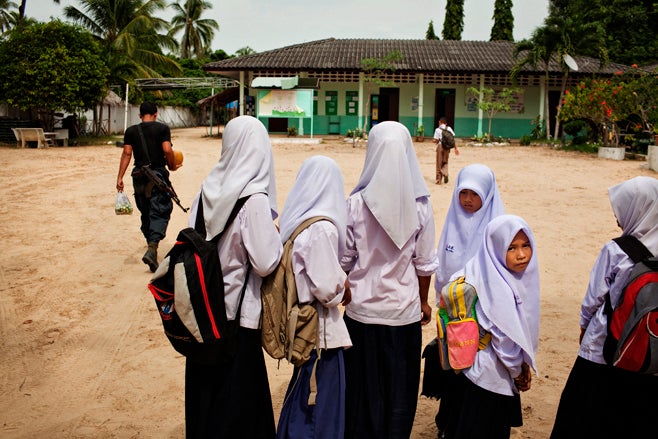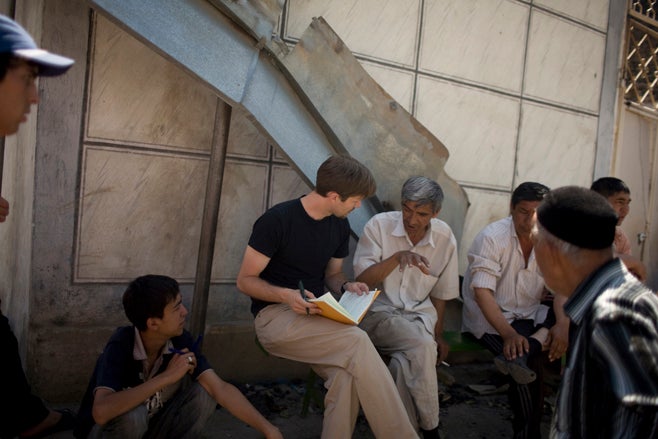US citizens enjoy a broad range of civil liberties and have recourse to a strong system of independent federal and state courts, but continuing failures-notably in the criminal justice and immigration systems and in counterterrorism law and policy-mar its human rights record. Although the Obama administration has pledged to address many of these concerns, progress has been slow; in some areas it has been nonexistent.
There were positive developments in 2010, including a Supreme Court ruling abolishing the sentencing of children to life in prison without parole for non-homicide crimes; a new law that promises to reduce racial disparities in the sentencing of cocaine offenders; and a healthcare law promising health insurance to an estimated 32 million uninsured Americans.
All of these topics were examined in November 2010 during the first-ever Universal Periodic Review of the US at the United Nations Human Rights Council, part of a larger process in which the Council examines the human rights records of all 192 UN member states.
Extreme Criminal Punishments
The number of US states that impose the death penalty remained at 35 in 2010. At this writing 45 people have been executed in the US thus far in 2010; 52 were executed in 2009.
There are 2,574 youth offenders (persons under age 18 at the time they committed their offense) serving life without parole in US prisons. There are no known youth offenders serving the sentence anywhere else in the world. In a historic decision in June 2010, Graham v. Florida, the US Supreme Court ruled that the sentence cannot be imposed on youth offenders convicted of non-homicide crimes. While the ruling was a significant step forward, most youth offenders serving the sentence were convicted of homicide and were not affected by the ruling.
Prison Conditions
As of June 2009 the US continued to have both the largest incarcerated population (2,297,400, a decrease of 0.5 percent since December 2008) and the highest per capita incarceration rate in the world (748 inmates per 100,000 residents).
17 months after the National Prison Rape Elimination Commission delivered its proposals to eliminate prison rape to the Justice Department, Attorney General Eric Holder still had not promulgated final standards. Sexual violence, meanwhile, remains commonplace in US prisons. The Bureau of Justice Statistics (BJS) reported in August 2010 that 88,500 prison and jail inmates had experienced some form of sexual victimization between October 2008 and December 2009. According to a survey mandated by the Prison Rape Elimination Act and analyzed by the BJS, an estimated 12 percent of youth held in juvenile facilities reported that they had been sexually abused.
There were advances in treatment of women in US prisons. In August the Washington Department of Corrections, following a court order, began to address staff sexual misconduct against women prisoners, including through revamping complaint and investigation procedures, installing additional surveillance cameras, and increasing training. The number of states restricting the shackling of pregnant prisoners grew from six to ten with Colorado, Washington, Pennsylvania, and West Virginia joining New York, Illinois, California, Texas, Vermont, and New Mexico. But there were highly disturbing developments as well: in Colorado, for example, women inmates were subjected to degrading, routine, suspicionless searches requiring them to open their labia for inspection by guards.
In California legislation went into effect in January 2010 that is designed to reduce the prison population by, among other measures, giving more good time credits and diverting certain parole and probation violators from prison. Nevertheless, California has appealed to the US Supreme Court a federal court order requiring the state to reduce its prison population so that it can provide constitutionally adequate medical and mental health care to inmates.
Despite the large number of prisoners in the US with histories of substance use and addiction, evidence-based drug dependence treatment is rarely available to them. HIV and hepatitis prevalence among prisoners is significantly higher than in the non-incarcerated community, yet proven harm-reduction programs, such as condom availability and syringe exchange, remain rare. The 2010 Human Rights Watch and American Civil Liberties Union (ACLU) report, Sentenced to Stigma, documented the harmful impact on prisoners and their families of prison policies that mandate HIV testing, breach confidentiality, and promote stigma and discrimination.
Harsh US prison conditions were further exposed in July when the European Court of Human Rights temporarily halted the extradition of four terrorism suspects from the United Kingdom to the US due to concerns that their long-term incarceration in a US "supermax" prison would violate Article 3 of the European Convention on Human Rights, which prohibits "torture or... inhuman or degrading treatment or punishment."
Racial Disparities in the Criminal Justice System
The burden of incarceration falls disproportionately on members of racial and ethnic minorities, a disparity which cannot be accounted for solely by differences in criminal conduct: black non-Hispanic males are incarcerated at a rate more than six times that of white non-Hispanic males and 2.6 times that of Hispanic males. One in 10 black males aged 25-29 were in prison or jail in 2009; for Hispanic males the figure was 1 in 25; for white males only 1 in 64.
In August 2010 President Barack Obama signed the Fair Sentencing Act, which alters the federal government's historically far more punitive approach to crack versus powder cocaine offenders that has led to racial disparities in sentencing. While symbolically important, the act does little to address the overwhelming racial disparities in drug law enforcement: blacks constitute 33.6 percent of drug arrests, 44 percent of persons convicted of drug felonies in state court, and 37 percent of people sent to state prison on drug charges, even though they constitute only 13 percent of the US population and blacks and whites engage in drug offenses at equivalent rates.
Rights of Non-Citizens
There are some 38 million non-citizens living in the US, of whom approximately 12 million are undocumented. In 2009 US Immigration and Customs Enforcement (ICE) detained between 380,000 and 442,000 non-citizens in some 300 detention facilities, at an annual cost of US$1.7 billion.
In May 2010, reports surfaced that ICE was investigating allegations that a guard at a Texas immigration detention center had sexually assaulted several female detainees. This was the latest in a series of alleged sexual assaults, abuses, and episodes of harassment that have come to public attention since ICE was created in 2003.
In a July report, Deportation by Default, Human Rights Watch documented barriers facing persons with mental disabilities in immigration proceedings, including a lack of legal safeguards and numerous cases of prolonged detention.
ICE made useful proposals in 2010 for better addressing sexual abuse in immigration facilities and mistreatment of detainees with mental disabilities, but few have been implemented at this writing.
In late 2009 Human Rights Watch reported on the problem of extensive transfers of immigrant detainees between facilities across the US. More than 1.4 million detainee transfers occurred between 1999 and 2008, interfering with detainees' rights to access counsel, witnesses, and evidence. In July 2010 ICE announced the launch of an online detainee locator system-an important reform-but Congress has taken no steps to check ICE's expansive transfer power and ICE has failed to promulgate a promised policy to reduce transfers.
ICE also continues to have sweeping deportation powers. In June Assistant Secretary John Morton wrote of his desire to prioritize the deportation of "dangerous non-citizen criminals." If implemented, this would be an important reform-the largest numbers of deportations have been of non-violent and low-level offenders-but prospects for change in ICE practices remains unclear at this writing.
According to figures released in 2010 by the Center for Constitutional Rights and other groups, 79 percent of deportations under ICE's "Secure Communities" program were of nonviolent and low-level offenders. Human Rights Watch's own analysis of government data showed that three-quarters of non-citizens deported between 1997 and 2007 were nonviolent or low-level offenders. Under draconian laws passed in 1996, judges in many deportation cases are given no discretion to allow immigrants convicted of such minor offenses to remain in the US, regardless of their lawful presence in the country, status as a spouse or parent of a US citizen, economic contributions, or service in the US military.
Congressional efforts to overhaul the immigration system continued to flatline. No immigration reform bill moved in Congress, including the DREAM Act-designed to help immigrant children who grow up in the US-which was originally introduced in 2001. The current system has created a massive underground of persons who have lived undocumented in the US for many years. According to the Pew Hispanic Center, 5.9 million undocumented persons (53 percent of all undocumented persons) have lived in the US for more than 10 years, and 1.4 million have lived in the country for more than 20 years. A July 2010 Human Rights Watch report, Tough, Fair, and Practical, describes how lawmakers' failure to reform US immigration law violates basic human rights principles.
Individual US states continued to propose problematic immigration laws in 2010. An Arizona law, SB 1070, authorized police to interrogate anyone they reasonably suspect to be undocumented. In July a federal court enjoined enforcement of the most controversial sections of SB 1070, including "reasonable suspicion" interrogations, on grounds that federal immigration law preempts the Arizona statute and that lawfully-present aliens would be impermissibly burdened by the law. The court's decision is under appeal.
Labor Rights
US workers continue to face severe obstacles in forming and joining trade unions, and the US government is failing to meet its international obligation to protect their exercise of these rights. Human Rights Watch supported the Employee Free Choice Act, a modest legislative proposal to reduce some of these obstacles, but a Senate filibuster threat has blocked the bill for two years.
Human Rights Watch's September 2010 report, A Strange Case, focused on violations of US workers' organizing and bargaining rights by European-based multinational corporations operating in the US. European firms that claim to comply with International Labor Organization core labor standards and other human rights laws too often violate these norms in their US operations, where labor laws offer substandard protections in key areas.
A May 2010 Human Rights Watch report, Fields of Peril, reported on the working conditions faced by hundreds of thousands of children who work on US farms. The 1938 Fair Labor Standards Act specifically exempts farmworker children from the minimum age and maximum hour requirements that apply to all other working children, exposing them to work at far younger ages, for far longer hours, and under far more hazardous conditions. Federal protections that do exist are often not enforced, and state child labor laws vary in strength and enforcement. As a result, child farmworkers, most of whom are Latino, often work 10 or more hours a day and risk pesticide poisoning, heat illness, injuries, and life-long disabilities. Many drop out of school and girls are sometimes subject to sexual harassment.
Health Policy
In March 2010 President Obama signed the Patient Protection and Affordable Care Act, which will provide health insurance to some 32 million uninsured Americans. However, the act's restrictions on how insurance companies may provide coverage for abortions are expected to impede abortion access.
In July 2010 the Obama administration issued the first National AIDS Strategy for the US. HIV infections in the US continue to rise at an alarming rate, particularly in minority communities, and many states continue to undermine both human rights and public health with abstinence-only restrictions on sex education, inadequate legal protections for HIV-positive persons, resistance to harm-reduction programs such as syringe exchange, and failure to fund HIV prevention and care.
Women's and Girls' Rights
Despite the Obama administration's stated support for ratification of the global women's rights treaty, the Convention on the Elimination of All Forms of Discrimination against Women, neither the administration nor the Senate moved toward ratification. The US now stands as one of only seven nations that have not joined the treaty. A bill to enhance US efforts to combat violence against women globally gained momentum in 2010, but remained pending in Congress at this writing.
In the workplace, women continue to make 77 cents for every dollar earned by men. The US is one of only a handful of countries that have no guarantee of paid maternity leave and pregnancy discrimination claims have risen sharply. Women remain significantly underrepresented at all levels of government, including in the US Congress, where they constitute just over 17 percent of members.
Women experiencing violence in the US face barriers to safety and justice. Thousands of requests for emergency shelter and transitional housing from domestic violence survivors go unmet every year, with federal funding for such services falling short of targeted levels. In July Human Rights Watch released a report showing that up to 80 percent of rape kits (DNA evidence collected from a victim's body) in the state of Illinois may never have been tested. The state is attempting to address this problem: Governor Pat Quinn signed a bill contemporaneously with the release of the Human Rights Watch report requiring local law enforcement officials to send rape kit evidence for testing, making Illinois the first state in the nation to do so.
Discrimination Based on Sexual Orientation and Gender Identity
US law offers no protection against discrimination based on sexual orientation or gender identity. The Uniting American Families Act, which would allow same-sex relationships between a US citizen and a foreign national to be recognized for immigration purposes, did not advance in Congress. The Defense of Marriage Act (DOMA), which prohibits the federal government from recognizing the relationships formed by same-sex couples, remains in force.
There have been steps at the state level to better protect the rights of lesbian, gay, bisexual, and transgender people. A federal district court in Massachusetts declared unconstitutional the DOMA provision that prohibits the federal government from recognizing same-sex marriages valid in other jurisdictions. Separate district courts in California ruled that the California constitutional amendment barring same-sex couples from marrying (Proposition 8) and the federal policy barring lesbian, gay, and bisexual people from serving openly in the military (Don't Ask Don't Tell) violate the US Constitution.
A move in Congress in May to repeal Don't Ask Don't Tell remains pending at this writing. The Employment Non-Discrimination Act-a bill that would prohibit discrimination in employment based on sexual orientation or gender identity at the federal level-is also pending before Congress.
Counterterrorism
Despite overwhelming evidence that senior Bush administration officials approved illegal interrogation methods involving torture and other ill-treatment, the Obama administration has yet to pursue prosecutions of any high-level officials or to establish a commission of inquiry. In January the Justice Department's Office of Professional Responsibility released a report concluding that top lawyers in the Bush-era Office of Legal Counsel did not violate legal ethics rules when they wrote memos authorizing so-called enhanced interrogation techniques, but rather "exercised poor judgment."
Although Attorney General Eric Holder appointed a federal prosecutor in 2009 to review post-9/11 interrogation practices, the prosecutor has yet to issue a report and, by all indications, the investigation is unlikely to examine the responsibility of senior officials who set the policies in place and authorized the abuses. The Obama administration's continued invocation of an overly broad understanding of the "state secrets" privilege was accepted by several courts, cutting off another possible avenue for redress for victims of torture and other abuses.
In transferring counterterrorism detainees abroad, the Obama administration said that it would continue to rely on "diplomatic assurances": non-binding and often unreliable promises from the receiving country that detainees would be treated humanely. In July the Obama administration transferred a detainee from Guantanamo to his native Algeria on the basis of such assurances, despite his claims that he would face torture or ill-treatment by the Algerian government or non-state actors.
The Obama administration missed its self-imposed deadline to shut down Guantanamo and failed to provide any real indication of when the facility would actually be closed. Although the administration did not seek to enact preventive detention legislation, it continues to hold suspects without charge at Guantanamo based on wartime detention authority. In May the administration announced its plans to continue to hold indefinitely at least 48 detainees who have already been in US custody for approximately eight years. Following an attempted attack on a US jetliner in December 2009 by a Nigerian man who allegedly trained with al Qaeda in Yemen, the administration stopped transferring detainees to Yemen, leaving 57 Yemeni detainees whose transfers had been approved stuck at Guantanamo indefinitely.
The political uproar that followed Attorney General Holder's announcement in November 2009 that Khalid Sheikh Mohammed and four other "high-value" detainees would be tried in federal criminal court led the administration to reconsider its decision. At this writing no decision has been made as to where and how they would be tried.
Meanwhile the administration pursued other cases in military commissions, including the prosecution of Ibrahim al Qosi, a Sudanese man who pled guilty but whose sentence was kept secret. The Obama administration also pursued the military commission prosecution of child soldier Omar Khadr, even though Khadr was only 15 years old when he was captured, and he was charged with an offense not considered to be a war crime. Despite some improvements to the military commissions, they continue to lack the basic guarantees of fairness found in US federal courts, allow certain evidence obtained coercively, discriminate against non-citizens, and are used to prosecute people for conduct that has never before been considered a violation of the laws of war, raising serious retroactivity concerns.



